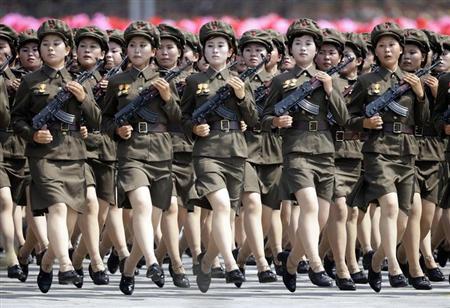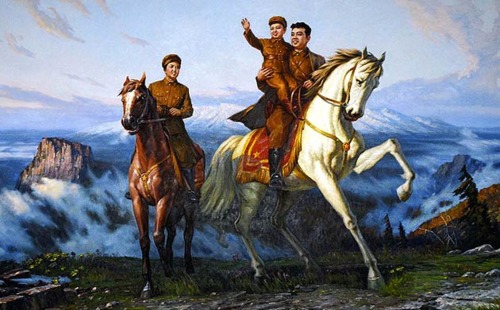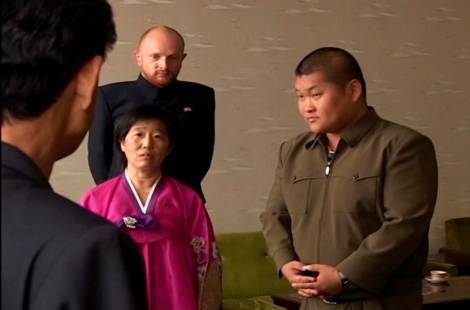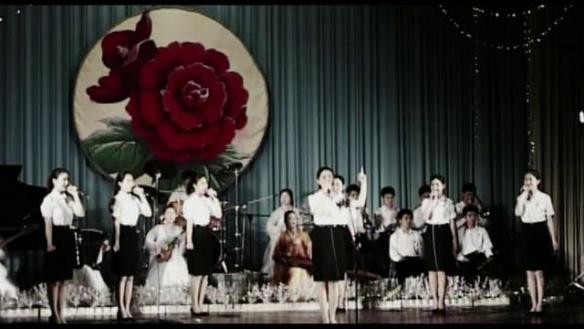North of the 38th Parallel. It is one of the most peculiar, enigmatic, and isolated corners of the world. Nobody knows what really goes on in there. What is their culture and society really like? What is their population? How does their economy function? Nobody ever goes in and nobody ever comes out. It must be run by Oompa-Loompas.
Seriously though, North Korea is one of the strangest places on earth. It’s another planet! It is a fascinatingly hidden, cult-ish culture shrouded beneath an overcast sky and the beaming benevolent portraitures of Kim Il-Sung and Kim Jong-Il [and now Kim Jong-un]. All media is government controlled and they are suspected of countless Human Rights violations. Even if you get in, you better watch your step and still you’ll only ever see and hear what North Korea wants you to see and hear. Great difficulties arise in any attempts to document and fairly assess this 46,528 square mile mystery. Difficulties, yes, but some have attempted nevertheless. The Vice Guide to Travel did an excellent piece on North Korea (watch it here), and there have been many more incredible amateur docs, but Danish filmmaker Mads Brügger took a slightly different approach with his Borat-esque documentary The Red Chapel (2009).

The hop-marching is kind of weird. I wonder how menacing ten thousand soldiers walking like Groucho Marx would be.
Brügger’s film would take both himself and two Danish-Korean comedians, Simon Jul and Jacob Nossell, deep into Pyongyang under the guise of a theater troupe that would be performing a traditional Danish comedy play as part of a cultural exchange for the people of the Democratic People’s Republic of Korea. In actuality, Mads really only seeks to expose North Korea as the soulless dictatorship he believes it is.
Another twist is that Jacob Nossell is a self-proclaimed “spastic” (he has a severe speech impediment and occasionally requires a wheelchair). This twist serves several purposes. Firstly Jacob can say almost anything in Danish because between the language and his vocal distortions he will be unintelligible to the North Koreans who will be examining all of the footage they take. The second purpose is to test the North Korean rumor that infants born with genetic maladies are euthanized (as reported by several physicians who have defected). Mads suspects the Red Chapel’s embarrassingly bad show is allowed to continue because the North Koreans seek to dispel this grim rumor and so Jacob and the Red Chapel’s show is to be used as propaganda. Brügger does admit that he is probably guilty of using Jacob for his own manipulative means as well.
The Red Chapel alternates between informative tourism and comical rehearsals where the North Koreans gradually deflate Denmark’s play and replace the entire story with even more convolutions, bizarrities, and pro-North Korean ideological propaganda. The irony is that the Red Chapel was compelled to agree not to incorporate any ideological or political themes in their performance and yet by the end of the movie the Red Chapel performers must conclude their show declaring, “One heart. One mind. One Korea. Together we fight. Together we die.” Another big alteration made to their show is the diminished role of Jacob. He must be in a wheelchair the whole show and only communicate via whistle squeaks while Simon does most of the act himself, and at the end of the show he must stand up (but not speak) so the audience will think he was only pretending to be handicapped. In this topsy-turvy world where Simon and Jacob must don Korean uniforms and regurgitate propaganda for a “cultural exchange,” they are constantly micro-managed by their DPRK tour guides who must evaluate, deliberate, and confer amongst each to other to ascertain the possible political themes of every move they make. For instance, what does the “pussy” in “pussy-cat” truly denote? Might it be dangerous to the North Korean government?
Several humorous, subversively subtle and ballsy events pepper the movie just to keep the comedy going. At the revered statue of deceased but eternal president, Kim Il-Sung, Mads Brügger requests to read a silly poem as a (rather absurd) sign of respect and as an offering to the great leader in the spirit of cultural exchange. They also present a pizza paddle to be given to Kim Jong-Il. For all the humor and fun being had, whether Simon is leading an impromptu rendition of “Hey, Jude” on guitar, or Jacob is making insightful quips regarding the vacuous horrors of all the emotionless enthusiasm, what really got me about The Red Chapel were the moments of naked humanity. Most of the evil rumors are never put to rest one way or another, but we do see real people. Mrs. Pak, their tour guide, is one of the most fascinating and compelling people on the screen. She is only allowed to smile and be happy (and keep the boys out of trouble). She cries at the statue of Kim Il-Sung, but Brügger tacitly wonders if she is crying out of love, out of fear, or for memories of pains past. After only a few hours of knowing Jacob, Mrs. Pak is embracing him and calling him “like my son…more than my son.” Tearfully she says ‘it is not mother’s work to send a boy like him away’. There appears to be much conflict within this woman at times. I found Mrs. Pak to be more fascinating an example than all the ghostly vacant streets and empty shops of Pyongyang. Does she know she lives under an oppressive government? Would she call it that? Does she truly know what the rest of the world is like? Is she brainwashed or is she really just that gung-ho? In a land where the only images you are allowed to see are propagandistic, can you not still choose to love it of your own volition? I found her presence and unwitting contribution to the film to be incredible. She genuinely wants to show the Red Chapel all that North Korea has to offer, but is her devotion derived out of cultural pride or fear? We may never know.
The constant lying and games of deception—on both the part of the filmmaker and of North Korea—takes its toll. Jacob has a nervous breakdown early on. During a gigantic celebration (that condemns the United States for attacking them in 1950 unprovoked, of course) Mads and Jacob—pushed in his wheelchair by the motherly Mrs. Pak—wind up marching down the square and having to cheer. Jacob alone defies this command and moans complaints unintelligibly. It is an extremely surreal and tense moment that puts the beads of sweat on Mads’ forehead. Beyond Borat, there is far more danger if their agenda is discovered and their charade is uncovered. They are mocking possibly one of the most dangerous, dehumanizing, and restrictive governments in the world. We never see the death camps or horrific prisons for political threats, but the possibility remains and the danger is always there.
On a tour of a school, the boys see doll-like children performing robotic paroxysms all to the glory of their leader. Il-Sung’s and Jong-Il’s portraits eerily hang in every room just to remind everyone that everything is all doubleplusgood in DPRK. Big Brother is watching. They smile and clap as long as the foreigner’s camera is pointed at them. The children practice and perform acts of programmed artistic perfection reminiscent of Disney’s “It’s a Small World” ride. When anyone is asked how they are or how anything is, the response is always one of hyperbolic ecstasy and joyous exaltation. In the Democratic People’s Republic of Korea no one is unhappy. North Korea is always portrayed as the most prosperous nation in the world. Everyone is in unison and the parades of thousands are never out of step. If Kim Jong-Il is as big a film-lover as is understood (so much so that he kidnapped director Sang-ok Shin and his wife and held him hostage to make movies for North Korea) then I just bet he’s a fan of The Stepford Wives. Watch excerpts from their famed Mass Games and you get a glimpse of their frighteningly awesome precision. People are pixels here.
As with The Vice Guide to Travel: North Korea [and their several followups with Dennis Rodman under Jong-un’s rule now], one never gets to see what lies behind certain doors. Movements are carefully planned out and must never deviate from the government controlled itinerary. One only gets to see what North Korea wishes to be seen and that is always maintained to be the very best. The sad, twisted irony of it all is that if what they show is North Korea’s best it still leaves much to be desired. There is a hollowness and a stifled melancholy about this country in its all-too flattering representation of itself. Perhaps I am revealing too much personal bias as an American [and one who lives in South Korea]. Coming from a country where differences are relished and celebrated and where many cultures and perspectives are encouraged and appreciated and where it is considered strange if everyone is the same and there is no dissenting voice, it is quite a culture shock to get a glimpse into North Korean society. Maybe we’re all just misinformed and it’s not bad or wrong at all, but whatever it is, it is the opposite of the American ideal of individualism.
I enjoyed The Red Chapel immensely. It may not offer more than a familiar peek into North Korea like some other documentaries, but it has a personality all its own. Following Mads, Simon, Jacob, and Mrs. Pak around in this dystopic world is worth the price of admission. For anyone interested in North Korea this is a must-see comedy documentary.
Originally published for “The Alternative Chronicle” May 16, 2011













